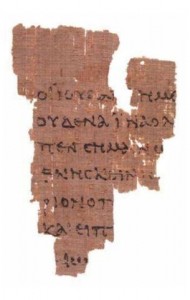
The Rylands Library Papyrus P52, thought to be the earliest extant fragment of a New Testament text. It contains part of the Gospel of John and dates between 117-138 A.D. It is displayed in a climate-controlled case at the John Rylands Library in Manchester, England.
The New Testament is a diverse collection of 27 books, mostly written during the first century A.D. by a range of authors. Four of these books, called the gospels, relate the life, ministry, death, and resurrection of Jesus. Another book, Acts of the Apostles, traces the early history of the Christian church as it was formed and began to spread. Twenty-one books are letters, written by various authors (one of whom was a very important missionary, Paul). These letters, or epistles, consist of doctrine, counsel, conflict resolution in the early church, and so on. A final book, Revelation, is a work of apocalyptic prophecy. Over the early centuries of Christianity, these 27 books became recognized as the church’s official canon.
Given the awesome span of time between their original writing and today, it’s no surprise that we no longer have the original texts. The books come down to us today thanks to the work of monks and scribes who, over the centuries, copied and recopied the scrolls, attempting to faithfully reproduce the texts and preserve them for future generations.
With all this in mind, can we be sure that the texts we have today have come down to us accurately? Can we know that the original intent and meaning of the authors has been faithfully transmitted?
Well, the short answer is yes, we can. Let’s explore why.
To start, we have a wealth of copies that have come down from different geographic areas and different time periods that we can compare to one another, looking for consistencies and inconsistencies. In fact, a fantastic number of copies still survive. Today, we have about 5,800 New Testament Greek manuscripts with diverse geographic and temporal origins. There are some inconsistencies, but the vast majority of them are slight differences in spelling and other simple issues. None affect core Christian doctrine or teaching. In addition, experts in textual criticism have been able to determine, with a high degree of confidence, the wording contained in the originals.
Our earliest manuscripts date to within 50-75 years of the originals! The oldest one is a fragment of the gospel of John, dated to 117-138 A.D. Many others date from the second and third centuries.
Compared to other ancient writings, 5,800 manuscripts is a tremendous amount. Consider these examples:
- Homer’s Iliad – We have about 1,800 Greek manuscripts, the oldest of which was written about 350-400 years after the original.
- Josephus’ The Jewish War – Originally written in about 75 A.D., only 9 Greek manuscripts survive, and they were created 900-1,000 years after the originals. We also have some Latin versions that were written 300 years after the originals.
- Tacitus’ Annals of Imperial Rome – Originally written in about 116 A.D., only one manuscript survives, and it is a copy from about 850 A.D.
The 5,800 Greek New Testament texts provide a far more robust bridge to the past than the relatively small number of surviving texts from other ancient writers. Keep in mind, Josephus is a very important source of Jewish history, and Tacitus is a critical source of ancient Roman history. Historians today rely mightily on their writings, and those writings come down to us through only a very few manuscripts.
So, we can be highly confident that the original New Testament materials have come down to us accurately. As the late Sir Frederic George Kenyon, expert in ancient manuscripts and former Director of the British Museum, summed up in his book, The Bible & Archaeology: “The last foundation for any doubt that the Scriptures have come down to us substantially as they were written has now been removed.”
Image Attribution:
“P52 recto” by Papyrologist Bernard Grenfell (1920), as preserved at the John Rylands Library. Photo: courtesy of JRUL. – Papyrus: preserved at the John Rylands Library. Photo: courtesy of JRUL.. Licensed under Public domain via Wikimedia Commons – http://commons.wikimedia.org/wiki/File:P52_recto.jpg#mediaviewer/File:P52_recto.jpg

Your article stated – “Homer’s Iliad – We have less than 650 Greek manuscripts”. Actually, experts now have recognized the number of Iliad copies in extant are at least twice that number. Just passing along so that we don’t look foolish when throwing statistics out there.
Andy, thank you for the catch. As recently as 2005, the recognized number was 647, and the source we had originally used was written prior to that year. However, you are correct. We have now checked later sources indicating that recent finds have pushed the number to nearly 1,800. That is an impressive number of manuscripts but, as you know, still far fewer than those we have for various parts of the NT. Thanks again for the catch, and the article has been updated.